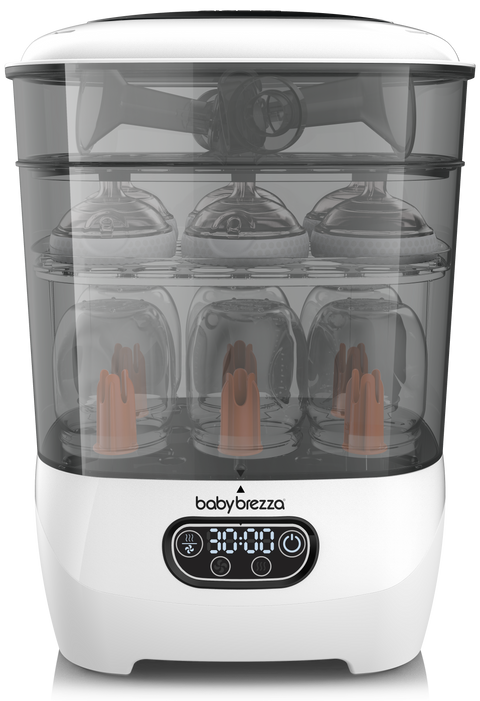Introducing your baby to a wide range of foods and tastes is an exciting part of parenting. It can be both fun and interesting to see what flavors and textures your little one enjoys. But how can you safely introduce potential allergens to your baby?
We’ve put together a simple food guide for quick reference when you’re whipping up a recipe or trying a new snack for baby. Of course, it’s always a good idea to check with your child’s pediatrician if you have questions related to health and diet.
Baby Food Guide
If you’re ready to put down the bottle (at least for a few minutes) and start offering your baby other options, follow the food guide below.
Babies Aged 4-6 Months
Stage: Baby can hold up his or her head, sit in a high chair unassisted, and move food to the back of the throat.
Pro Parent Tip: Pediatricians still recommend that babies get their nutrition from breastmilk or formula at this stage – so don’t throw out your baby bottle just yet! But it’s ok to start getting baby used to eating solid foods at this stage.
A word of caution: If you introduce baby to sweet fruits before veggies, you may accidentally create a sweet tooth in your little one. Try to focus on green vegetables and less sugary fruits before moving onto sweeter choices.
Common Choices:
- Rice cereal (less likely to be an allergen than other grains, such as wheat)
- Green beans
- Butternut squash
- Sweet potatoes
- Peas
- Avocado
- Apples
- Bananas
How to Prepare:
At this early stage, you want to make sure that anything you offer to your baby won’t pose a choking hazard. Be sure to puree all solids for easy swallowing.
The Baby Brezza One Step Baby Food Maker Deluxe is the easiest way to make homemde baby food purees. It automatically steams, then blends homemade baby food is as little as 10 minutes.
Serving Suggestion:
Use a spoon to offer small bites to your baby. If they refuse, don’t force the issue. At this stage, it’s all about slow introductions. It may help, though, to awaken baby’s appetite with a little breastmilk or formula, and then offer a few bites of puree.
Babies Aged 6-10 Months
Stage: Your baby is swallowing purees and his or her appetite is increasing. By about 9 months, your little one is probably eating 3 meals a day along with a snack or two.
Pro Parent Tip: Don’t feel like you have to follow a rigid order of food introductions – instead focus on making sure that whatever you give your baby is the appropriate texture and consistency.
Experts recommend waiting at least 3 days in between introducing new foods. This window of time will help you to better identify any foods that cause an intolerance or allergic reaction in your baby.
Common Choices:
- Oatmeal
- Quinoa
- Broccoli
- Cucumber
- Beets
- Grapes
- Cherries
- Pasta
- Toast
- Tofu
- Eggs
- Chicken
- Turkey
- Pork
- Beef
These are just a few of the many options now available to your baby. Many nutritionists say that you can really start to expand your baby’s palette during this stage – as long as you monitor the texture and match your baby’s abilities with the foods you pick.
How to Prepare:
Pureed foods are still the staple of your baby’s diet at this point, but the texture your baby can safely eat may be slowly thickening.
Since your baby will be eating more frequently, be prepared with healthy, ready-to-go meals in convenient reusable baby food pouches. Store them in the fridge or freezer until your little one is ready for a meal or snack. Clean-up is easy, since the pouches are dishwasher-safe.
Serving Suggestion:
As your baby starts to use their thumb and forefinger to pick up pieces of food, you can begin introducing lumps of food. Keep a close eye, though, on the size of each bite and the speed at which your child chews it up to avoid choking hazards.
Babies Aged 10-12 Months
Stage: Your baby is eating several meals a day, with a wide variety of foods included. They’re picking up pieces of food and increasingly wanting to self-feed.
Pro Parent Tip: Aim to give your baby a variety of foods to avoid a picky eater and for the best possible nutrition.
New Additions:
- Corn
- Tomatoes
- Cow’s Milk
- Citrus
- Strawberries
- Spinach
- Honey (Do not introduce until baby is at least 12 months)
How to Prepare:
Your baby is likely eating more and more solids by this point and enjoying small bites of food.
You may still be softening some tough-to-chew foods, but experts encourage parents to have babies eating various textures by this point to avoid developing a gag reflex.
Serving Suggestion:
Your little one should be mimicking your healthy, well-balanced diet at this stage (you didn’t forget about the food pyramid for yourself, did you?).
For your baby’s meal plan, aim to include six servings of grains, two or three servings each of vegetables and fruits, two servings of protein, and three servings of milk.
Note about Peanuts:
Peanuts may be one of the most feared food allergies. The National Institute of Health in the USA recently advised parents to begin introducing peanuts to babies at high-risk of developing the allergy at 4-6 months. For babies without any risk factors for the allergy, they recommend freely introducing peanuts in an age-appropriate form.
Follow the Food Guide – and Your Parenting Sense – for a Healthy Baby
Make mealtime fun as you introduce new foods and fun textures. Keep going even when it doesn’t go as planned – and you end up with pea puree splattered on the wall.
While a food guide can be a great tool to quickly check on age-appropriate foods, remember that your parenting sense is a big help too. After all, you were born to do this!






 تيك توك
تيك توك